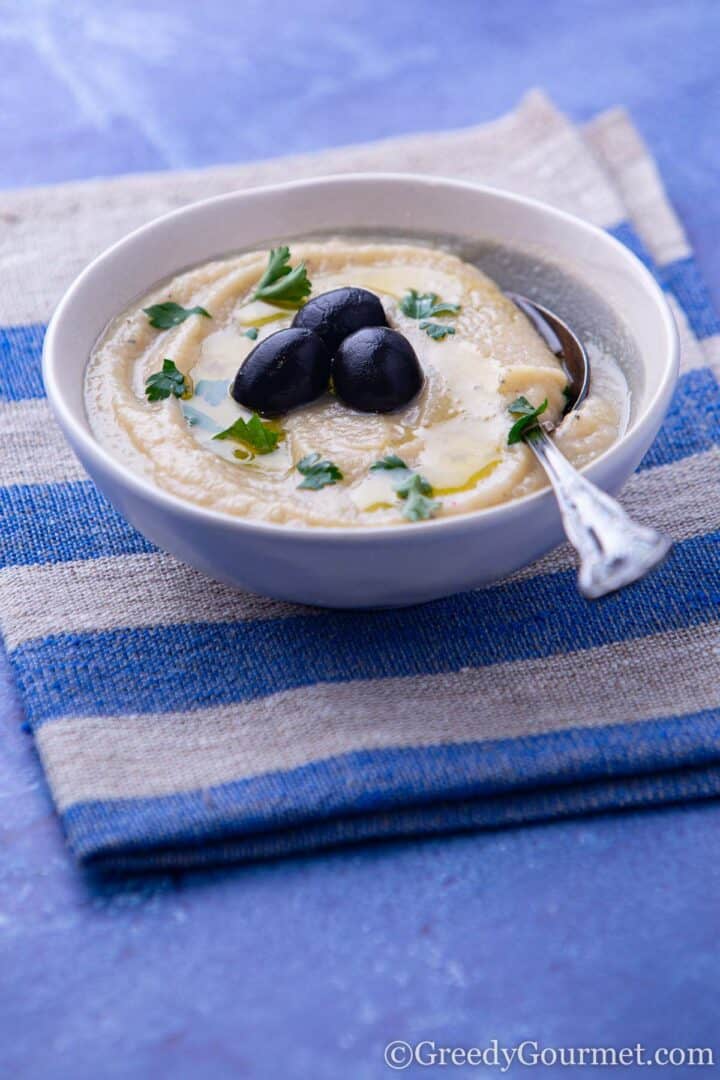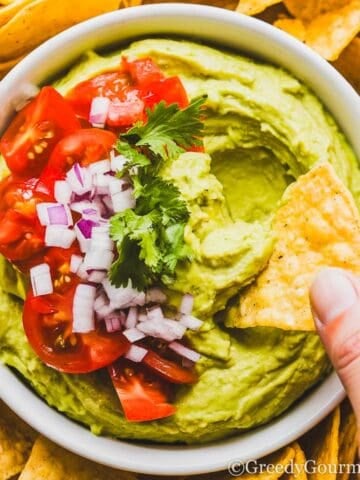Turnip Skordalia is a Greek dip that’s creamy, garlicky, and a bit unexpected with its use of turnips. It’s a bold, flavorful addition to any table. For more unique dips, take a look at my dip recipes.

Are you ready for your new favorite keto side? Let’s go!
Products you need for this recipe
Here are a few key items you’ll need for this recipe:
- Deep baking tray – make sure you’ve got a large roasting tray to roast your turnip, garlic and other ingredients
- Food processor – you’ll need a good quality food processor to blitz your roast turnip into a heavenly texture
- Olive oil – go for a quality extra virgin olive oil, either Greek or Italian. It will make all the difference

What is skordalia?
Healthy AND tasty? Well, this is Greek cuisine we’re talking about after all. If you’re a fan of Greek food – let’s be honest, who isn’t – then you’re got to give this simple side dish a go.
A Greek potato dip or side that’s a standard in households and restaurants across Greece and beyond, skordalia is creamy, garlicky and full of flavor.
Its origins of this potato dip are thought to stretch all the way back to the Ancient Greeks, who loved all things garlic, mashed or otherwise, and swore that several cloves of garlic were ideal for health and wellbeing.
While methods and recipes have changed a lot over the years, the traditional Greek method retains its simplicity and dedication to the prep work.
Traditional Greek garlic and potato skordalia is made slowly and carefully, with a pestle and mortar to mash the potato, rather than a food processor or blender. This allows the starch of the mashed potatoes to break down slowly, while oil, water and garlic are added bit by bit.
The result is a creamy, heavenly potato dip, rather than the sticky, gummy consistency that you get by whizzing up mashed potatoes in a food processor.
Of course, nowadays, there are many alternatives to using mashed potatoes, particularly for those following a keto diet. That’s where my delicious turnip skordalia comes in!
Wait… isn’t skordalia basically just mashed potatoes?
Say that to a Greek, I dare you.
No, absolutely not. It’s all about the prep and the combination of flavors. Also, for me, the thing that separates this recipe from plain old mashed veg is the addition of a quality extra virgin olive oil.
It gives it a wonderful silky smooth texture. Plus, with the mixture of oil and butter, it’s a lot lighter than the standard stodgy side dish that you would normally think of on the side of a roast, for example.
Is turnip skordalia keto?
Yes! This is the classic Greek garlic dip with a keto spin on it.
For years, the standard alternative to Greek garlic and mashed potatoes skordalia has been stale bread. Well, I’m here to rip up the recipe book and suggest a better alternative to mashed potatoes for the modern era… the humble turnip.
It’s one of those vegetables that’s so often overlooked. However, not only are turnips good for you, they can be really tasty when paired with the right ingredients. Plus, they produce great texture to a dish when cooked and prepared in the right way.
For me, Greek garlic skordalia is the perfect fit. Rich, earthy garlic with its unique taste, silky smooth delicious olive oil, lemon juice, a sprinkling of quality sea salt and a hint of citrus.
It keeps the spirit of the original, with that magical simplicity that makes Mediterranean food so special, yet adds a modern healthy low-carb twist.
You can also add nuts for that extra depth and a splash of red wine vinegar for extra acidity.
How do you pronounce “skordalia?”
Don’t worry… a lot of people have trouble pronouncing it! The Greeks pronounce it “Score-dal-ya.” Very satisfying when you put extra emphasis on the “YA” at the end!
Why is it called “skordalia?”
The word garlic in Greek is “skórdo,” so the thick garlic dip became known as skordalia.
Is turnip skordalia garlicky?
Yes, very! So, if you’re not a fan of the taste of garlic or if you’re a vampire, you might want to look elsewhere.
However, if like me, you can’t get enough garlic in your life, this is the side dish for you. The garlic flavor is very potent, as it’s not cooked. Instead, you add the garlic raw, then mash it into the turnip.
Is skordalia served hot or cold?
It’s best served warm, but is still delicious when chilled. Whatever floats your boat!
Could you make it in advance?
Absolutely. Turnip skordalia will last from 3–5 days in the refrigerator when stored in an airtight container.
You can also heat it through if you’d rather serve it warm. Simply place it into a saucepan and heat gently until fully warmed.
Should I use extra virgin olive oil in turnip skordalia?
To make this recipe, you’ll need a quality olive oil. Typical of Greek cuisine, skordalia uses a lot of olive oil to flavor the dish and give it the right texture.
So, take my advice… don’t be tempted to skimp on quality here and go for a standard vegetable oil, for example. The Greeks – and the Italians for that matter – really know what they’re doing when it comes to producing amazing quality extra virgin olive oil.
When you get the right stuff, extra virgin olive oil is good for you and delicious. See ‘Products you need for this recipe’ above for my recommendation on which oil you should choose.
How do you eat skordalia?
The Greeks have served skordalia with fried fish for centuries. When you taste the two in combination, you can certainly see why!
It works equally well when served with meat. Whether it’s chicken, turkey, ham, pork or beef, a generous helping of turnip skordalia would add a completely new dimension.
As well as a side, it also makes a great dip. Skordalia can be used with simple breadsticks, crudités, crackers or lots of other types of simple finger food.

Would you like to save this?
Wine pairing for turnip skordalia
Turnip skordalia pairs well with a full-bodied red – something to really work in harmony with the strong earthy taste, particularly the punch of garlic.
For me, a Chilean Merlot would be perfect. If you prefer white, a Burgundy Chardonnay would also pair really well with this dish.

More delicious Greek favorites
If you’re a fan of Greek cuisine, you won’t want to miss out on these classic recipes:
- Moussaka – probably the number one classic Greek dish. Eggplant, lamb mince, tomato, garlic and potato combine for a truly special meal
- Greek fava – ideal as a starter or the perfect veggie spread on toast or crackers, the Greek fava is a pea-based recipe that is pure vegan comfort food
- Htipiti – another delicious peppery garlic dip, this one is a smoky, rich peppery dip that’s really easy to make and packs in so much flavor
- Taramasalata – authentic Greek food doesn’t get any better than this. You’ll never eat another store bought taramasalata after trying this homemade marvel
- Vegan moussaka – the vegan spin on the Greek classic, this uses rich lentils in place of lamb. The result is enough to make a meat eater’s mouth water, as well please the most discerning of vegans
- Melitzanosalata – charred eggplant makes this traditional dip truly unique
📖 Recipe

Turnip Skordalia
- Total Time: 1 hour 20 minutes
- Yield: Serves 4
- Diet: Vegetarian
Description
This simple Greek Turnip Skordalia has a keto twist to fulfil your dietary requirements. Learn how to make this tasty side dish.
Ingredients
- 450g (1lb) turnips, peeled and chopped
- 8 garlic cloves, peeled
- 60ml (4 tbsp) olive oil
- 250ml (1 cup) vegetable stock
- 5ml (1 tsp) lemon juice
- 15ml (1 tbsp) butter
- salt and pepper
Instructions
- Preheat the oven to 180°C / fan 160°C / 355°F / gas mark 4.
- Place all the ingredients in a deep baking tray, cover with foil, then bake for 25 minutes.
- Remove the foil and bake for another 25 minutes.
- If there is still some liquid left, tip the content in a pot and bring to the boil, stirring regularly, until all liquid has evaporated.
- Tip the contents in a food processor and blend until smooth.
- Transfer the sauce into a serving dish and drizzle with oil before serving. Enjoy!
- Prep Time: 20 minutes
- Cook Time: 1 hour
- Category: Side Dish
- Method: Bake
- Cuisine: Greek
Nutrition
- Serving Size:
- Calories: 191
- Sugar: 4.9 g
- Sodium: 812.1 mg
- Fat: 17.3 g
- Saturated Fat: 3.9 g
- Trans Fat: 0 g
- Carbohydrates: 10.1 g
- Fiber: 2.2 g
- Protein: 1.4 g
- Cholesterol: 7.7 mg





Timit
As a native greek I must say you have nailed this recipe to perfection!
Michelle Minnaar
Thanks Timit, means a lot!